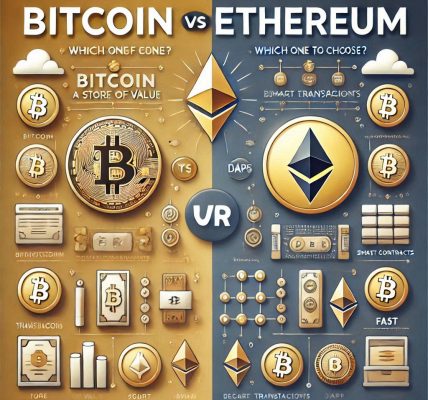Introduction
Cryptocurrency exchanges are the backbone of digital asset trading, allowing users to buy, sell, and trade cryptocurrencies. These platforms are broadly classified into two types: Centralized Exchanges (CEXs) and Decentralized Exchanges (DEXs). Each has its advantages and disadvantages, catering to different types of users.
But which one is better? Should you trade on a CEX for its user-friendly interface or opt for a DEX for its security and privacy features? In this detailed comparison, we will explore the key differences, pros and cons, and the best exchanges to use in 2025.
Disclaimer: This article is for informational purposes only and should not be considered financial advice. Always conduct your own research before using any cryptocurrency exchange.
What is a Centralized Exchange (CEX)?
A Centralized Exchange (CEX) is a platform operated by a central organization that facilitates cryptocurrency trading. It acts as an intermediary between buyers and sellers, managing order matching, liquidity, and security.
How Does a CEX Work?
- Users deposit funds into the exchange’s wallet.
- The exchange holds the funds and manages order execution.
- Trading occurs within the exchange’s infrastructure.
- Users can withdraw funds from the platform.
Popular Centralized Exchanges in 2025
- Binance – Largest exchange by trading volume, offering diverse crypto pairs.
- Coinbase – Beginner-friendly, highly regulated in the U.S.
- Kraken – Advanced trading tools and strong security.
- KuCoin – Wide range of altcoins and trading features.
- OKX – Strong derivatives trading and staking options.
Pros of Centralized Exchanges ✅
✅ High Liquidity – CEXs offer deep liquidity, allowing fast trades with minimal slippage. ✅ User-Friendly – Intuitive UI, easy deposits, and fiat integration for beginners. ✅ Advanced Trading Features – Futures, margin trading, staking, and lending options. ✅ Regulation & Compliance – Many CEXs comply with legal frameworks, increasing trust. ✅ Customer Support – Dedicated support teams help users resolve issues.
Cons of Centralized Exchanges ❌
❌ Custodial Risks – Exchanges control user funds, making them vulnerable to hacks. ❌ Regulatory Issues – Governments can impose restrictions or shut down exchanges. ❌ High Fees – CEXs charge higher trading, withdrawal, and deposit fees. ❌ KYC Requirements – Users must complete identity verification, compromising privacy.
What is a Decentralized Exchange (DEX)?
A Decentralized Exchange (DEX) is a platform that allows peer-to-peer (P2P) cryptocurrency trading without intermediaries. Trades are executed through smart contracts on blockchain networks.
How Does a DEX Work?
- Users connect their crypto wallets to the DEX.
- Orders are matched through automated market makers (AMMs) or order books.
- Smart contracts execute the trade directly between users.
- Funds remain in users’ wallets throughout the transaction.
Popular Decentralized Exchanges in 2025
- Uniswap (Ethereum-based) – Most popular AMM-based DEX.
- PancakeSwap (BNB Chain-based) – Low fees and high speed.
- SushiSwap – Multi-chain DEX with governance features.
- dYdX – Advanced derivatives trading with decentralized governance.
- Curve Finance – Best for stablecoin swaps with minimal slippage.
Pros of Decentralized Exchanges ✅
✅ Full Control of Funds – Users maintain custody of their crypto at all times. ✅ Privacy & Anonymity – No KYC verification required in most cases. ✅ Lower Fees – No intermediaries mean lower trading costs. ✅ Censorship-Resistant – No central authority to block trades or freeze assets. ✅ Access to New Tokens – Many new cryptocurrencies list on DEXs before CEXs.
Cons of Decentralized Exchanges ❌
❌ Lower Liquidity – DEXs often have lower trading volumes than CEXs. ❌ Slower Transactions – Trade execution depends on blockchain network congestion. ❌ User Complexity – Requires knowledge of crypto wallets and smart contracts. ❌ Smart Contract Risks – Vulnerabilities in code can lead to exploits and hacks.
Centralized vs. Decentralized Exchanges: A Direct Comparison
| Feature | Centralized Exchange (CEX) | Decentralized Exchange (DEX) |
|---|---|---|
| User Control | Exchange holds funds | Users control funds |
| Security | Vulnerable to hacks | Smart contract risks |
| Privacy | Requires KYC | No KYC required |
| Liquidity | High liquidity | Lower liquidity |
| Fees | Higher fees | Lower fees |
| Trading Speed | Faster | Slower (depends on network) |
| Ease of Use | User-friendly interface | Requires crypto knowledge |
| Regulatory Risks | Subject to government laws | Less susceptible |
| Features | Futures, staking, lending | Limited trading options |
Which Exchange Should You Use?
Use a CEX If:
✅ You are a beginner who needs a user-friendly experience. ✅ You want access to advanced trading tools and fiat integration. ✅ You prefer higher liquidity and faster trade execution. ✅ You are comfortable with KYC requirements and regulations.
Use a DEX If:
✅ You value privacy and do not want to complete KYC verification. ✅ You prefer full control over your crypto funds. ✅ You are trading new or less common tokens not available on CEXs. ✅ You want to participate in DeFi projects and decentralized governance.
Conclusion: The Future of Crypto Exchanges
Both centralized and decentralized exchanges offer unique benefits and cater to different types of users. CEXs provide convenience, liquidity, and a broad range of features, making them ideal for traders who prioritize ease of use. DEXs, on the other hand, offer security, privacy, and full control over assets, appealing to those who prioritize decentralization.
As the cryptocurrency space evolves, we may see a hybrid model where exchanges integrate features from both CEXs and DEXs. Regardless of the platform you choose, always prioritize security, conduct thorough research, and use best practices when trading digital assets.
Disclaimer: Cryptocurrency investments are risky. Do your own research before trading on any platform.




